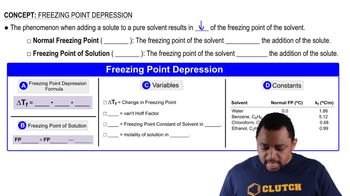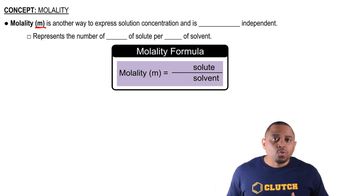Here are the essential concepts you must grasp in order to answer the question correctly.
Freezing Point Depression
Freezing point depression is a colligative property that describes the lowering of a solvent's freezing point when a solute is added. The extent of this depression is directly proportional to the molality of the solution and the freezing-point-depression constant (Kf) of the solvent. For water, Kf is typically 1.86 °C kg/mol, meaning that for each mole of solute per kilogram of solvent, the freezing point decreases by this amount.
Recommended video:
Freezing Point Depression
Molality
Molality (m) is a measure of concentration defined as the number of moles of solute per kilogram of solvent. It is particularly useful in colligative property calculations because it directly relates to the effect of solute on the properties of the solvent. Unlike molarity, molality is not affected by temperature changes, making it a stable measure for solutions in thermal calculations.
Recommended video:
Dissociation of Ionic Compounds
Ionic compounds, such as KBr, dissociate into their constituent ions when dissolved in water. For KBr, it dissociates into K⁺ and Br⁻ ions. This dissociation increases the number of particles in solution, which is crucial for calculating colligative properties like freezing point depression, as the effect is based on the total concentration of solute particles rather than just the number of solute molecules.
Recommended video:
 Verified step by step guidance
Verified step by step guidance

